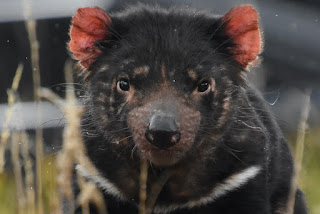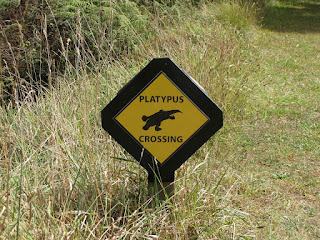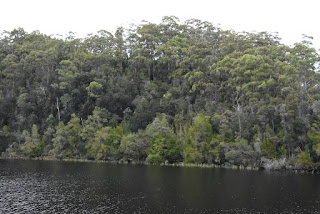From the Tamar Wetlands we headed West. To do this we had to go through Launceston, but that was OK. We had some shopping to do. We located a supermarket on what looked like, and turned out to be, our route to the West. The idea was to park on the street, but we didn't see a suitable length of free kerb. Luckily, the supermarket's car park did have space to park the camper van without any tricky manoeuvring and no-one stopped close to us while we were inside so the departure was equally straightforward.
Our destination was Mole Creek, where we had a campsite booked. According to our field guide there are no moles in Tasmania, so the choice of name seems a bit odd.
We stopped for a late lunch at The Hearth of Chudleigh, an establishment that describes itself as an emporium, cafe and event space. It's certainly unusual. All the books, bric-a-brac and what have you on display are for sale. The cafe delivered good quality food and coffee, and bookings were being taken for a Japanese dinner that evening. No, we didn't double back from Mole Creek to try the Japanese food.
A little further long the road was the Trowunna Wildlife Sanctuary. Hadn't we seen enough marsupials already on this trip? Obviously not. We were just in time for the afternoon education session. Well, we only missed the first couple of minutes of the talk, illustrated with live examples.
Most of the animals live in cages or pens.
And of course wild creatures come and share the attention.
The Mole Creek campground was quite small for a commercial one. We had booked a powered site. It advertised that there were platypuses in the creek that flowed through the campground, but all the creekside sites were unpowered. We were directed to likely areas for a sighting and asked not to walk uninvited though other people's campsites.
All directions for platypus spotting recommend starting half an hour before dusk, since they are generally nocturnal and crepuscular creatures. So we used the late afternoon for doing laundry. We had the necessary coins to operate the washer and dryer but it was a frustrating exercise. The design of the washing machine was unfamiliar, the instructions were a bit obscure and we have to admit to not reading them carefully enough.
We studied the stream before sunset, after sunset and again in the morning. Not a hair of a platypus did we see. A lady on the same errand told us that she had seen some at Geeveston, in slower-moving and deeper water. Clearly she was sceptical that this was genuine platypus habitat.
Something the campground didn't offer was a dump station. Living in a vehicle requires positive action to get rid of waste. There is grey water from washing dishes and bodies, and black water from using the toilet cassette. We had been told by another camper, not by the rental company, that it was OK to simply empty the grey water on to the grass. After that we often witnessed the practice and followed suit. We even stayed at a campground that specifically asked campers to do so. Black water is definitely not to be poured onto the ground. Sewerage has to be disposed of at specially constructed dump stations.
The nearest one was in the nearby town of Sheffield. In fact, the app showed two dump stations in Sheffield. Only there weren't. The first one was a complete fiction. The local tourist information confirmed the location of the second one and we were duly able to empty our cassette. We reported the error in the app, but it is still appearing.
After properly disposing of our waste it was clearly time for a coffee. We drove back into Sheffield and parked by the first cafe we could find. Bossimi's Bakehouse and Cafe was indeed a find. The coffee was excellent and the accompanying snacks good enough to persuade us to buy filled rolls to take with us for our lunch.
By now we had visited 3 wildlife sanctuaries in Tasmania, but no gardens. Bill suggested we visit the Tasmanian Arboretum at Eugenana, knowing how interested Eve is in trees and plants. When we arrived, however, Eve said that first of all we should visit the lake as the information about the place said that platypuses could be seen there sometimes. When we began to walk around, we saw a couple of women standing on a bridge pointing at something which duly turned out to be a platypus! We watched for some time whilst having a pleasant chat with the women who were in Tasmania for a car rally.
It was very difficult to make out the shape of the platypus as it swam just below the surface, every now and then doing a sort of hunch and dive. Eve remarked that it looked like it was “doing a moonie”. We watched for quite some time and then decided to walk around the lake to enjoy the scenery and the flora.
When we came back to our starting place some time later, the two women had returned and were once again watching the platypus’s movements. Eve couldn’t resist and said to them, “You see those big trees over there?” They nodded and so she said, “Well, there’s a man in there with a remote making a mechanical platypus move about for visitors!” They looked stunned for a moment and then began to laugh. Gotcha!!
There are two reasons why this post is not accompanied by poster-sized pictures of a platypus:
Bill had the wrong camera for wildlife photography. The Canon is an excellent camera for landscapes, trees, close ups of leaves, etc. but does not have the zoom power of the lens attached to the Nikon. And at maximum zoom the focussing is less reliable.
The progress of a swimming platypus can be described as submarining. All you can see from a distance is some ripples. Maybe there is a nostril or two just above the surface, but nothing of substance. If it's not too far away you can make out a blurry shape. Then, without warning, the animal hunches up in a 'duck dive' and you see some brown fur before it goes deep.
This is the least worst of the pictures we got. The duck-bill is coming towards the camera. The lump at the back is presumably a rear foot.
At the far side of the lake is a hide for watching the platypus and water birds. If they bother to label the hide in that way maybe the resident platypuses are regularly active in the daytime. We saw another two on that side of the lake.
By the time we decided we should move on we hadn't learned much about trees, but we had certainly enjoyed ourselves.
Our destination that day was Stanley, near the NW corner of the island. Most of the driving was on a busy main road. It was a good surface without tight bends, but the constant need to keep an eye on following traffic, which generally wants to pass you, is a stress. Then there was a very long roadworks, with stop-start traffic. Taking a short detour to a Table Cape lookout gave a breather, but then we had to turn around in a very narrow road. All in all it was a relief to arrive in Stanley.
The campground was opposite the Stanley Recreation Ground. No facilities, but heaps of level space and a lovely view over the bay. Across the road the local Aussie Rules team was training. They looked awfully young and fit.
Sites aren't marked, so we left a camp table to mark our spot when we went in search of a meal. One of Stanley's attractions is the Hursey Seafoods restaurant. The Hursey family owns a fleet of fishing boats so the food has to be fresh. Lonely Planet was a bit sniffy about the lack of ambience in the restaurant (“The locals prefer the takeaways”), but it seemed OK to us and it was certainly more comfortable than squashing into the camper van. We splurged. The seafood platter for two is $90, but it comprises battered gummy, crumbed striped trumpeter, crumbed scallops, salt ‘n’ pepper squid, oysters Kilpatrick & natural, marinated octopus, salad, chips, tartare & seafood sauces. Eve doesn't like oysters so Bill swapped some his scallops, octopus and squid. Perfectly cooked. Possibly the world's best fish and chips.
They offer crayfish, of course. On the day we were there the prices were North of $100. We both like crayfish, but there is a limit. In New Brunswick 5½ years ago it cost us about $17 each for a lobster dinner. On a nearby table an Asian family had ordered crayfish. The family included possibly the fattest man we have ever seen. He was clearly enjoying his luxury meal.
In the morning we considered the Nut. This is an old volcanic plug that dominates the town. There are said to be nice walks on its almost flat top. To get to the top it is a 20 minute strenuous climb or a chairlift ride. Neither was terribly appealing. And in the event, the chairlift didn't seem to be operating that morning.
Our mission for the day was to drive to Strahan. We had booked a boat tour for the following morning. Nowhere in Tasmania is more than a day's drive from anywhere else in Tasmania, so it wasn't a gruelling trek. The first part was retracing our route towards Launceston, but for some reason there was a lot less traffic and it flowed steadily through the road works. There were even fewer vehicles sharing the road once we turned inland, but the road got narrower and there were plenty of corners to be taken slowly. There was also rain. This is entirely usual for Tasmania; in fact what was unusual was the absence of more than the odd shower on every other day.
A pause in Tullah during a break in the rain. Random bits of mining machinery are displayed for those interested in the industrial history of Tullah.
The Henty Dunes Picnic Area was just off our route. It was only about 200 metres, but the road was unsealed and a mess of potholes. The dune(s) is/are enormous. We didn't attempt the climb to see the ocean and whatever else was beyond.
The staff at the Big 4 campground in Strahan seemed uncertain about our booking, but found us a site anyway. We asked where the boat tour left from. “About 10 minutes that way” with a vague wave of the arm. We asked about parking and were advised that, “There's no meter maids so you'll be all right if you don't pay.” Some of us have a more ethical approach.
It was a long 10 minutes walk, but we found the wharf and a tourist information office. The nice lady there indicated the boat tour office. When we asked about parking she explained that there was a charge for the big car park that we had just walked past, but we could park outside the information office for nothing.
So in the morning we got ready early and parked ethically outside the information office, collected our boarding passes and looked forward to our cruise.
The Gordon River Cruise had been strongly recommended to us before we left home. Folk we spoke to in Tasmania also warmly endorsed it. And advised that we book early. Our main deck window seats cost us $200 each. The upper deck was offered at $350!
In the event, the day we took the cruise was not fully booked and everyone could go outside onto the viewing decks without congestion.
The tour of Macquarie Harbour and the Gordon River is well presented with commentary and the European history of the area. Much of it is done by actors dressed as figures from the area's past and relayed on large screens.
We learned that Macquarie Harbour is the second largest harbour in Australia, and six times the size of Sydney Harbour. Was there a little dig at Sydneysiders in the latter factoid? Much of the Northern part of Macquarie Harbour is very shallow. A nineteenth century engineer, whose name we have forgotten, built a training wall that altered the natural currents to carve a navigable channel. The same engineer built a sea wall at the remarkably narrow harbour entrance.
The entrance is called Hell's Gates. At the time our vessel was there the hazards were very clear. There are lots of rocks either side of the channel that were barely covered by the ocean. Many ships have hit these rocks, and the sad tale of the only fatal disaster was related to us.
A special announcement: a sea-eagle was in view. Bill, of ourse was there with his telephoto lens, but even a big bird is very difficult to photograph at two or three hundred metres.
Macquarie Harbour is home to a few salmon farms. We were given a close-up view of one of them.
Once in the Gordon River the diesel engines were turned off and the propellors were driven by electric motors. Gliding silently up the river was very nice.
Much is made of the lunch provided on the tour. It is a buffet, but very nicely presented and you can have as much smoked salmon as you want. Bill went round for a second helping.
We disembarked for a guided view of the forest … at Heritage Landing in a World Heritage Area. How very appropriate.
The skipper turned the boat around very efficiently and headed back to Macquarie Harbour. Once again a sea-eagle was spotted and once again it was a long way off.
The last destination was Sarah Island. This was another penal colony. It was where the convicts were sent when they broke the rules at Port Arthur or one of the other penitentiaries. It was the harshest, most brutal place where a convict could be sent.
For some years it was a shipyard with convict and thus essentially slave labour. The last ship built was stolen and used to stage an escape.
Our guide was well informed and presented the history with energy and humour. At the end of the tour he advertised a performance of The Ship that Never Was, a play based on the ship that was stolen. Back on board the tour boat Bill asked him which part he played. Sometimes you can tell when an actor is performing.
Back in Strahan we bought some souvenirs and started our journey towards Cradle Mountain.


.jpeg)
.jpeg)

.jpeg)
.jpeg)












.jpeg)


.jpeg)

.jpeg)


.jpeg)

.jpeg)
.jpeg)
.jpeg)
.jpeg)






1 comment:
Thanks for sharing , fun reads and very informative . How do you even remember all the details !!
Post a Comment